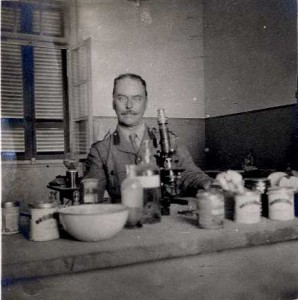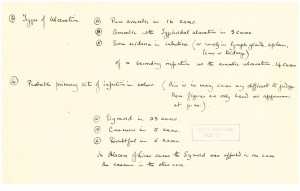It was initially assumed that the cases of dysentery were bacillary; however Ross believed and proved that many of the cases were amoebic dysentery which meant prolonged illness and cases of liver abscesses. In Ross’ notes on ‘Dysenteric Ulceration of Colon, no 21 General Hospital’, indicates there was 16 cases of dysenteric ulceration of the colon was ‘pure amoebic’ in 33 case studies.
In his report to the Principal Director of Medical Services, Ross notes that pathological departments were treating cases of dysentery as bacillary, whilst all the while the number of cases was growing rapidly. Ross was concerned that if these cases of amoebic dysentery were not treated correctly and quickly, the level of damage to the patient’s intestinal lining would be greatly increased. In response to these findings, Ross proposed that, ‘all medical officers at the front …should be asked to use emetine (a drug used for the treatment of amoebic dysentery) in all cases showing any dysenteric symptoms whatever’; fortunately, Ross’ proposal was accepted resulting in cases of, ‘much less critical conditions’.
In his report, Ross also mentioned his research on intestinal amoebic and if they were able to multiple in faecal matter laid upon damp sand. Ross, along with his research assistant David Thomson, concluded that they failed in proving this with ‘typical pathogenic amoebae’, but discovered that amoeba limax (amoebozoa typically found in soils), also found in human intestines, is able to live in a dormant state when attached to sand particles and then propagate when given another nutrient material, such as faeces.
Ross finished his report with a number of suggestions, including increasing the number of pathologists in each hospital, and that those patients who have been treated successfully for malaria and dysentery be sent home with medical cards outlining their medical notes in case of relapse.
When the outbreak of dysentery ceased, Ross made a short visit to Salonika to inspect anti malaria work and then returned to England, arriving on 30 November 1915.
In the Archives there is a large collection of material on Ross’ work in Alexandria including photographs of the 21 General Hospital in Alexandria where Ross worked, garrison orders warning troops not to clean cutlery with unsterilized sand, nominal roll of admissions for dysentery for Number 17 General Hospital, post mortems on cases showing dysenteric ulceration of colon at 21 General Hospital by George Bertram Bartlett and charts showing incidence of bowel complaints in the Mediterranean Expeditionary Force by David Thomson.
For further information, please contact the Archives Service at archives@lshtm.ac.uk







